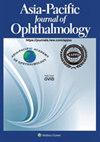评价光动力疗法作为新血管性AMD的辅助治疗:一项综合荟萃分析。
IF 4.5
3区 医学
Q1 OPHTHALMOLOGY
引用次数: 0
摘要
目的:本研究旨在评估光动力疗法(PDT)作为抗血管内皮生长因子(Anti-VEGF)玻璃体内注射在治疗新生血管性年龄相关性黄斑变性(nvAMD)中的辅助作用。方法:检索PubMed、Cochrane Library和ClinicalTrials.gov从成立到2023年的关键词“黄斑变性”、“光动力疗法”、“安慰剂”、“雷尼单抗”、“贝伐单抗”或“阿非利塞普”。纳入的研究是同行评审的原始数据,报告了nvAMD联合抗vegf和PDT、单独抗vegf、玻璃体内曲安奈德或安慰剂12个月的治疗结果。最终分析纳入了23项研究。主要结果为12个月时最佳矫正视力(BCVA)、视网膜中央厚度(CRT)和注射负荷。结果:与抗vegf相比,抗vegf + PDT在12个月时具有更好的BCVA (MD -0.07;95% ci -0.12, -0.01;P = 0.02)。抗vegf + PDT组与抗vegf组12个月CRT无显著差异(MD -3.66;95% ci -10.28, 2.98;P = 0.28)。与抗vegf组相比,抗vegf + PDT组的注射次数明显减少(MD -1.76;95% ci -1.95, -1.58;P < 0.0001)。抗vegf + PDT组与抗vegf组的眼部综合不良事件无显著差异(MD 0.96;95% ci 0.68, 1.36;P = 0.41)。结论:PDT是抗vegf注射治疗nvAMD的有效辅助手段。联合用药可改善12个月时的BCVA,降低注射负担,且眼安全性无差异。本文章由计算机程序翻译,如有差异,请以英文原文为准。
Evaluating photodynamic therapy as an adjuvant treatment for neovascular AMD: A comprehensive meta-analysis
Purpose
This study aimed to assess the role of photodynamic therapy (PDT) as an adjunct to anti-vascular endothelial growth factor (Anti-VEGF) intravitreal injections in the treatment of neovascular age-related macular degeneration (nvAMD).
Methods
PubMed, Cochrane Library, and ClinicalTrials.gov were searched for keywords “macular degeneration” and “photodynamic therapy” and “placebo” or “ranibizumab” or “bevacizumab” or “aflibercept” from inception to 2023. Included studies were peer-reviewed primary data reporting 12-month treatment results of nvAMD with anti-VEGF and PDT, anti-VEGF alone, intravitreal triamcinolone, or placebo. 23 studies were included in the final analysis. The major outcomes were best-corrected visual acuity (BCVA), central retinal thickness (CRT), and injection burden at 12 months.
Results
Anti-VEGF + PDT had better BCVA at 12 months compared to anti-VEGF (MD −0.07; 95 % CI −0.12, −0.01; P = 0.02). There was no significant difference in CRT at 12 months in anti-VEGF + PDT group versus anti-VEGF (MD −3.66; 95 % CI −10.28, 2.98; P = 0.28). Anti-VEGF + PDT group had significantly fewer injections compared to anti-VEGF (MD −1.76; 95 % CI −1.95, −1.58; P < 0.0001). There was no significant difference in pooled ocular adverse events between anti-VEGF + PDT versus anti-VEGF (MD 0.96; 95 % CI 0.68, 1.36; P = 0.41).
Conclusions
PDT is a successful adjunctive to anti-VEGF injections for the treatment of nvAMD. The combination of the therapies leads to improved BCVA at 12 months, decreased injection burden, and no difference in ocular safety.
求助全文
通过发布文献求助,成功后即可免费获取论文全文。
去求助
来源期刊

Asia-Pacific Journal of Ophthalmology
OPHTHALMOLOGY-
CiteScore
8.10
自引率
18.20%
发文量
197
审稿时长
6 weeks
期刊介绍:
The Asia-Pacific Journal of Ophthalmology, a bimonthly, peer-reviewed online scientific publication, is an official publication of the Asia-Pacific Academy of Ophthalmology (APAO), a supranational organization which is committed to research, training, learning, publication and knowledge and skill transfers in ophthalmology and visual sciences. The Asia-Pacific Journal of Ophthalmology welcomes review articles on currently hot topics, original, previously unpublished manuscripts describing clinical investigations, clinical observations and clinically relevant laboratory investigations, as well as .perspectives containing personal viewpoints on topics with broad interests. Editorials are published by invitation only. Case reports are generally not considered. The Asia-Pacific Journal of Ophthalmology covers 16 subspecialties and is freely circulated among individual members of the APAO’s member societies, which amounts to a potential readership of over 50,000.
 求助内容:
求助内容: 应助结果提醒方式:
应助结果提醒方式:


